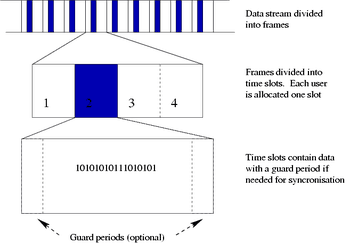Time Division Multiple Access (TDMA) stands as a pivotal technology in the evolution of telecommunications, particularly in cellular networks. This method of data transmission has played a crucial role in shaping how we communicate, paving the way for advancements in mobile technology. In this comprehensive exploration, we delve into the essence of TDMA, tracing its journey from inception to its impact on current cellular technologies. Our discussion encompasses a detailed examination of TDMA’s workings, contrasts with related technologies, and its evolution within the sphere of cellular networks, particularly in the context of 5G technology.
Table of Contents:
- What is TDMA?
- Evolution of Cellular Phone Technologies
- How TDMA Works
- Differences Between TDMA and TDM
- Advantages and Disadvantages of TDMA
- Where We Stand Now – 5G Technology
- References

1. What is TDMA?
Time Division Multiple Access (TDMA) is a digital wireless telephony transmission technology. It stands out in the realm of mobile communications as a method that divides frequency bands into time slots. Each slot is allocated to a different user, thus enabling multiple devices to share the same frequency without interference. Originally employed in 2G networks, TDMA efficiently uses the allocated spectrum, making it a foundational technology in the evolution of mobile networks.
TDMA operates by assigning time intervals to each communication channel, ensuring that these channels do not overlap and cause interference. This precise coordination is crucial in maintaining the integrity of transmitted data. The technology’s ability to handle multiple users on a single frequency band, while minimizing crosstalk and signal degradation, marked a significant advancement in wireless communication methods.
2. Evolution of Cellular Phone Technologies
The evolution of cellular phone technologies presents a fascinating journey, with TDMA playing a central role. In the early stages of mobile communication, analog systems like the 1G network laid the groundwork. However, with the advent of 2G, digital technologies such as TDMA and GSM (Global System for Mobile Communications) began to dominate, offering enhanced clarity, security, and data services.
TDMA’s implementation in 2G networks was a pivotal moment, marking the shift from analog to digital. This transition brought about significant improvements in capacity, data transmission rates, and spectrum efficiency. Following TDMA, technologies like CDMA (Code Division Multiple Access) and later 3G and 4G networks emerged, each introducing more advanced mechanisms for handling data and voice transmission.
The continuous advancement in cellular technologies eventually paved the way for 5G, the latest generation. 5G technology, while not relying on TDMA, builds upon the principles of efficient spectrum usage and high data rate transmission that TDMA introduced. The legacy of TDMA is evident in the way modern networks handle multiple user access and manage the ever-growing demand for bandwidth.
3. How TDMA Works
TDMA has evolved from the Advanced Mobile Phone Service (AMPS), which was developed in 1979. Time Division Multiple Access operates on a sophisticated principle that allows multiple users to share the same frequency channel by dividing the signal into different time slots. Each user is assigned a unique time slot within each cycle, a structure that ensures exclusive access to the channel for the duration of that slot. This method effectively reduces interference and maximizes the utilization of available bandwidth.
Example:
123123123...
Each cellular user is assigned the time slices with a given number and transmits information only for the duration of his or her time segments using the TDMA scheme. This means that voice communication must be buffered and transmitted as short bursts. The time segments are so small and the slicing frequency is so high that the user perceives a continuous communication channel. Time Division Multiple Access allows more communication sessions to be crammed onto a single cellular channel.

TDMA is used by both the 800-MHz frequency band of Digital Advanced Mobile Phone Service (D-AMPS) and the 1900-MHz frequency band of Personal Communications Services (PCS) technologies.
The first version of TDMA was developed in 1991 and was known as the IS-54 standard (developed by the EIA/TIA). It divided each 30-KHz channel into three multiplexed subchannels. A revised version using digital control channels was developed in 1994 and is known as the IS-136 standard or, more popularly, D-AMPS. Another cellular phone technology that is based on TDMA is the Global System for Mobile Communications (GSM), which multiplexes eight subchannels into a single 200-KHz channel.
Round-robin Arrangement
The functioning of TDMA can be visualized as a round-robin arrangement where users transmit in rapid succession, one after the other, each using their own time slot. This cycle repeats continuously, allowing seamless and simultaneous communication for multiple users. The key to TDMA’s efficiency lies in its synchronization. The base station synchronizes the timing of all users, ensuring that each transmission starts and stops precisely at the designated times, thus avoiding overlaps and interference.
This synchronization is critical in maintaining the integrity of the data being transmitted. The digital nature of TDMA also allows for error detection and correction mechanisms, which are essential in maintaining high-quality communication. Additionally, TDMA’s structure makes it more energy-efficient for mobile devices, as they only need to transmit during their assigned slots, conserving battery life.
4. Differences Between TDMA and TDM
While TDMA (Time Division Multiple Access) and TDM (Time Division Multiplexing) share a common principle of time-based division of channels, their application and context of use differ significantly. TDM is a broader concept used in various forms of communication, including wired networks, where multiple signals or data streams are combined over a single communication channel. In contrast, TDMA is specifically tailored for wireless networks to allow multiple users to share the same frequency band.
The primary difference lies in their approach to channel access. TDM is generally used in a scenario where a single transmitter and receiver share multiple channels over the same link. On the other hand, TDMA is designed for scenarios where multiple transmitters and receivers (like in cellular networks) need to share the same channel without interference.
Another key distinction is in the synchronization requirements. TDMA requires stringent synchronization between the mobile device and the network to ensure that the time slots are adhered to without overlap. TDM, being more flexible, does not demand such precise synchronization, as it is often employed in controlled environments like wired networks.
5. Advantages and Disadvantages of TDMA
Advantages of TDMA:
- Efficient Spectrum Utilization: TDMA’s time-slot approach enables multiple users to share the same frequency band without interference, maximizing the efficiency of the spectrum.
- Reduced Crosstalk and Interference: By allocating distinct time slots to each user, TDMA minimizes the risk of signal interference and crosstalk, ensuring clearer communication.
- Energy Efficiency: Mobile devices in a TDMA system only transmit during their assigned time slots, which conserves battery life as they are not constantly active.
- High Capacity: TDMA’s structure allows a large number of users to communicate simultaneously over the same network, which increases the capacity of the system.
Disadvantages of TDMA:
- Synchronization Challenges: The requirement for precise synchronization between the user’s device and the network can be complex, especially in environments with signal delays.
- Time Slot Limitations: The fixed nature of time slots can lead to inefficiencies if the traffic is unevenly distributed, as some slots may remain underutilized.
- Susceptibility to Multipath Interference: TDMA signals can be more susceptible to multipath interference, where signals take multiple paths to reach the receiver, potentially causing distortion.
6. Where We Stand Now – 5G Technology
While TDMA was a cornerstone in earlier generations of cellular networks, the advent of 5G technology marks a significant shift. 5G does not rely on TDMA; instead, it uses more advanced technologies like OFDMA (Orthogonal Frequency Division Multiple Access) and massive MIMO (Multiple Input Multiple Output) to achieve higher data rates, lower latency, and increased capacity.
The shift to 5G reflects an evolution towards handling more data-heavy applications, supporting a vast number of devices (IoT), and providing a more reliable and faster user experience. 5G’s approach to spectrum usage is far more dynamic and flexible compared to the rigid time-slot methodology of TDMA. This flexibility allows 5G networks to cater to the diverse and ever-growing demands of modern communication needs, from high-speed internet access to real-time control systems.
Despite its reduced prominence in current technologies, the legacy of TDMA is still evident. The principles of efficient spectrum usage and time-based multiplexing laid down by TDMA continue to influence modern telecommunications technologies.
7. References
The information in this article is supported by a variety of authoritative sources, including books, technical papers, and RFCs (Request for Comments). Below is a list of key references that provide further reading and in-depth understanding of Time Division Multiple Access (TDMA) and related technologies:
Books:
- Rappaport, Theodore S. “Wireless Communications: Principles and Practice.” Prentice Hall, 2002.
- Stallings, William. “Wireless Communications & Networks.” Pearson Education, 2005.
- Lee, William C.Y. “Mobile Cellular Telecommunications.” McGraw-Hill, 1995.
Technical Papers and Journals:
- Sklar, Bernard. “Digital Communications: Fundamentals and Applications.” Prentice Hall, 2001.
- Proakis, John G. “Digital Communications.” McGraw-Hill, 2001.
RFCs:
- RFC 1122 – Requirements for Internet Hosts – Communication Layers.
- RFC 2460 – Internet Protocol, Version 6 (IPv6) Specification.
Websites and Online Resources:
- IEEE Xplore Digital Library: A comprehensive collection of technical literature in electrical engineering, computer science, and electronics.
- ITU (International Telecommunication Union) Publications: Provides documents and reports on telecommunications standards, including those related to TDMA and cellular technologies.
- Cellular Phone Technology: Network Encyclopedia